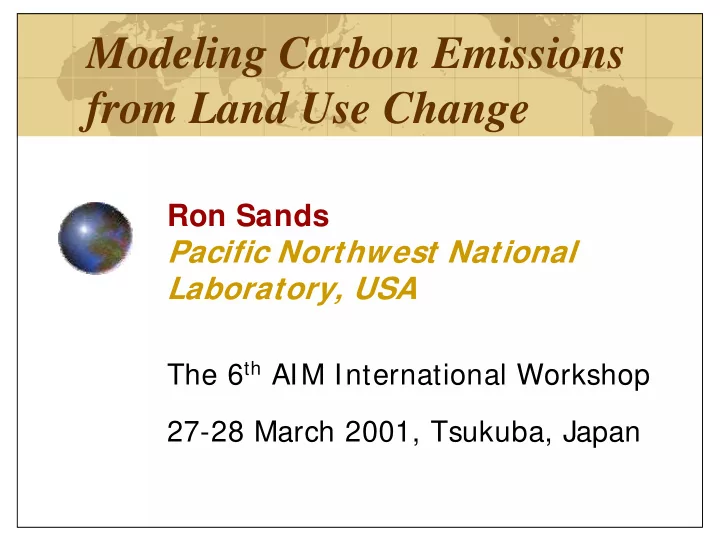

Modeling Carbon Emissions from Land Use Change Ron Sands Pacific Northwest National Laboratory, USA The 6 th AIM International Workshop 27-28 March 2001, Tsukuba, Japan
Presentation Overview Why model agriculture and land use? AgLU model overview Land use and demand for food Scenarios of land use change Model development Battelle Memorial Institute Pacific Northwest National Laboratory
Why Model Agriculture? Carbon emissions from energy consumption are not the whole story. Carbon emissions from land-use change Carbon mitigation using biomass fuels CH 4 and N 2 O emissions from agriculture Impact of climate change on agricultural productivity Battelle Memorial Institute Pacific Northwest National Laboratory
AgLU Regions Annex I Non-Annex I USA and Canada (NAM) Latin America (LAM) Western Europe (WEU) Middle East (MEA) Eastern Europe (EEU) Africa (AFR) Former Soviet Union China and Centrally- (FSU) Planned Asia (CPA) Japan, Australia, New South Asia (SAS) Zealand (PAO) Other Pacific Asia (PAS) Battelle Memorial Institute Pacific Northwest National Laboratory
AgLU Model Structure Supply Solution Mechanism Demand Local Taxes & Subsidies Climate Population Income Technology Local Price Supply of Crops, Demand for Crops, Livestock, World Biomass Livestock, & Biomass Energy, & Market Price Forest Products Forest Products Land Use Emissions
Methodology Highlights Forest Dynamics Trees in AgLU grow for 45 years Two forest markets (current and future) needed for model stability Land Allocation Land owners compare economic returns across crops, biomass, pasture, and future trees Underlying probability distribution of yields per hectare Battelle Memorial Institute Pacific Northwest National Laboratory
Land Allocation unmanaged pasture forest food coarse oil other biomass grains grains crops crops crops Battelle Memorial Institute Pacific Northwest National Laboratory
Demand for Food Crops Rice, Wheat, Coarse Grains Starchy Roots, Fruits, Vegetables, Pulses Processed Crops Vegetable Oils Sweeteners Alcoholic Beverages Animal Products Beef, Pork, Poultry Milk, Butter, Eggs Battelle Memorial Institute Pacific Northwest National Laboratory
Global Food Balance (kcal per person per day) Activity Final Demand Processed Animal Other Stock Total Crops Crops Products Food Uses Change Production Crops 344 748 1,041 1,726 51 49 3,959 Processed Crops 0 0 2 532 80 -4 609 Animal Products 0 0 37 382 38 0 457
1990 Food Consumption 4,000 3,500 3,000 2,500 Animal Products kcal per person 2,000 Processed Crops per day Crops 1,500 1,000 500 0 NAM LAM WEU EEU FSU MEA AFR CPA SAS PAS PAO Battelle Memorial Institute Pacific Northwest National Laboratory
Demand for Food α β = ij ij X A P Y N C ijt ij ijt ijt jt ijt i = crops, processed crops, animal products j is a region index t is time X is quantity demanded A is a constant to calibrate the price and income feedback terms P is price Y is per-capita income N is total population by region C is calories consumed per person per day in base year Battelle Memorial Institute Pacific Northwest National Laboratory
Land Use (reference case) 10 9 8 Unmanaged 7 billion hectares 6 5 Managed Forest 4 3 Pasture 2 1 Crop Land 0 1990 2005 2020 2035 2050 2065 2080 2095
Land Use (increased animal products) 10 9 8 Unmanaged 7 billion hectares 6 Managed Forest 5 4 Pasture 3 2 1 Crop Land 0 1990 2005 2020 2035 2050 2065 2080 2095
Land Use (+ animal products, C policy) 10 9 8 Unmanaged 7 Biomass billion hectares 6 Managed Forest 5 4 Pasture 3 2 1 Crop Land 0 1990 2005 2020 2035 2050 2065 2080 2095
Land Use (reference case) 10 9 8 Unmanaged 7 billion hectares 6 5 Managed Forest 4 3 Pasture 2 1 Crop Land 0 1990 2005 2020 2035 2050 2065 2080 2095
Land Use (increased animal products) 10 9 8 Unmanaged 7 billion hectares 6 Managed Forest 5 4 Pasture 3 2 1 Crop Land 0 1990 2005 2020 2035 2050 2065 2080 2095
Land Use (+ animal products, C policy) 10 9 8 Unmanaged 7 Biomass billion hectares 6 Managed Forest 5 4 Pasture 3 2 1 Crop Land 0 1990 2005 2020 2035 2050 2065 2080 2095
Carbon Emissions from Land Use Change 1,400 1,200 1,000 Carbon Policy and Increased Animal Products 800 Increased Animal Products Tg C Reference 600 Historical 400 200 0 1990 2005 2020 2035 2050 2065 2080 2095
Model Development Climate impacts CH 4 and N 2 O emissions from agriculture Crop management and carbon sequestered in soils Embed in CGE Framework Water Supply and Demand Battelle Memorial Institute Pacific Northwest National Laboratory
Climate Impacts Previous ENSO study for North America El Nino (EN) Strong El Nino (SEN) El Viejo (EV) Climate change and crop yields CO 2 at 365 ppmv and 560 ppmv GCMs: UIUC, UIUC+ sulfates, BMRC Climate Sensitivity: 1.0 ° C and 2.5 ° C EPIC crop growth model Battelle Memorial Institute Pacific Northwest National Laboratory
Table III.17. Average Yields across EPIC Representative Farms (Mg ha -1 ) Average Deviation from Average Yield Country Crop N EN SEN EV US Corn 7.05 -0.61 -0.54 -0.12 US Winter Wheat 1.76 -0.13 0.11 -0.02 Canada Barley 3.91 -0.15 -0.16 0.10 Canada Canola 2.68 -0.02 -0.01 -0.01 Canada Spring Wheat 2.53 -0.07 -0.02 0.16 Mexico Corn 5.10 -0.33 0.02 0.05 Mexico Beans 1.16 0.00 0.09 -0.08 Mexico Wheat 1.75 0.39 0.30 0.17 Mexico Irrigated Corn 7.18 -0.20 0.13 0.08 Mexico Irrigated Beans 2.55 0.03 -0.03 0.03 Mexico Irrigated Wheat 4.53 0.05 0.08 -0.18
Recommend
More recommend